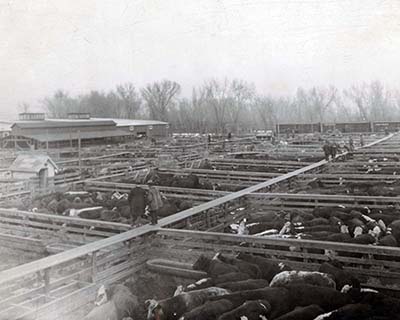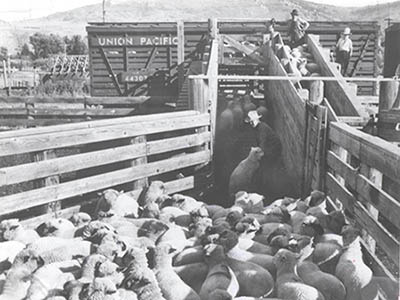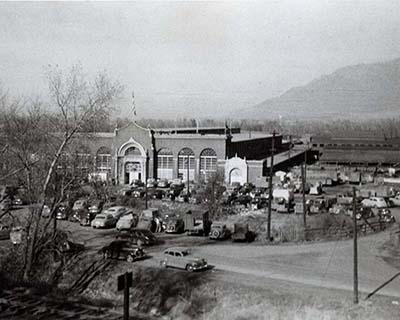Public Can Relive Ogden Stockyard History Thanks to WSU Project
OGDEN, Utah — The public now has access to the rich history of the Ogden Stockyards, thanks to an online exhibit from Weber State University’s Stewart Library Digital Collections.
WSU’s library staff collaborated with a class of public history students on a project to preserve the stockyards’ unique history. More than 50 years of material was digitally archived and is now available to browse online through the Stewart Library at dc.weber.edu/cdm/search/collection/OSY.
The exhibit includes interviews with people whose lives revolved around the stockyards as well as historical photographs and scans of artifacts collected through the years, such as cow tags, receipt books, journals and scrapbooks.
“For some of the people we interviewed, their best memories are involved in the stockyards,” said Jamie Weeks, University Archives & Digital Collections associate curator. “It was a big part of their life, and the impact was bigger than I’d expected.”
The Ogden Stockyards were once the economic center of the city. Located beside the Weber River in West Ogden, they were a mecca for livestock exchange from 1917 to the 1970s. It was the largest stockyard between Denver and the Pacific Coast, making it a major railroad stop. Although the days of cattle auctions and booming agriculture are gone, the memories are still strong.
“To know that the west side of Ogden was a huge commercial district is great,” said Sarah Langsdon, associate curator of Special Collections. “It was an interesting tie of big money, the railroad and people from all over, so it became a meeting ground for all different types.”
 Weeks and Langsdon led the task of creating a historical account of the stockyards with the help of students in History 3400: Principles of Public History. The students conducted interviews and collected more than 100 artifacts.
Weeks and Langsdon led the task of creating a historical account of the stockyards with the help of students in History 3400: Principles of Public History. The students conducted interviews and collected more than 100 artifacts.
“I think we gave the students successful exposure to different aspects of public history and what they would do within the field,” Weeks said. “Being able to apply this in a classroom setting gave them great hands-on experience.”
One of the students involved, Chelsee Boehm, graduated from WSU in May and is pursuing her master’s degree in applied historical research at Boise State University. Boehm said her dream job is to work in a museum.
“A lot of times, history students are just reading or talking about things that have happened in the past,” Boehm said. “To actually get involved and work on this project for most of the semester was really fun.”
She said the stockyards’ history is a good example of how things change over time.
“In the beginning, the stockyards were small,” Boehm said. “They grew and changed with the railroad, then they kind of died out when trucking became prominent because people could ship their animals with trucks.”
Today, all that remains of the old stockyards are a few reminders of the hustle and bustle that used to be. One such example is the Exchange Building, which served as the stockyards’ office at 600 W. Exchange Road. It was originally designed in the 1930s by architect Leslie Hodgson, whose work also included Ogden High School and Peery’s Egyptian Theater.
Ogden City is now renovating the building and the surrounding area into a 51-acre business park. Plans for the redevelopment are centered on the Exchange Building, where many of the artifacts collected by WSU will be displayed. The rest of the business park will cater to lifestyle-based companies. The proximity to the Weber River paths and bike trails will allow the area to incorporate industrial work and recreation. The first phase of construction will be near completion in summer 2016.
Ogden City solicited WSU’s Special Collections to help preserve the stockyards’ history during its renovation. Langsdon then attended a public open house and groundbreaking event for the business park in November 2014 and met people who had lasting memories of the area. She then devised a way to capture and share the stories.
“There’s been a real interest and resurgence in Ogden’s history lately,” Langsdon said. “For the community, this is a great way to remember a big part of their life.”
People who may have artifacts or stories to share about the stockyards can still contribute to the project by calling Stewart Library Special Collections, 801-626-6540.
Visit weber.edu/wsutoday for more news about Weber State University.
For high-resolution photos, please visit the following links:
Rachel Badali, Office of Marketing & Communications
801-626-7295 • rachelbadali@weber.edu- Contact:
Sarah Langsdon, Special Collections associate curator
801-626-6337 • slangsdon@weber.eduJamie Weeks, University Archives & Digital Collections associate curator
801-626-6486 • jweeks@weber.edu